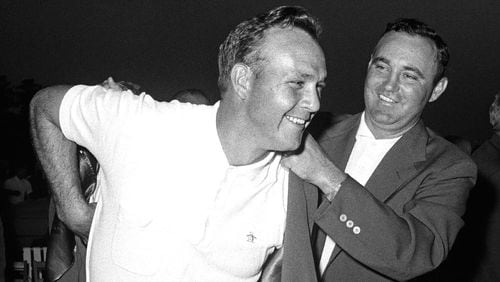Over the next six days, The Atlanta Journal-Constitution will look back on the significant anniversaries that fall on the upcoming 2018 Masters.
Today: 60th anniversary – Arnold Palmer wins first Masters
The 1958 Masters, the 22nd installment of the tournament, was the first after Augusta National Golf Club installed two stone arch bridges that span Rae’s Creek. One at the green at No. 12 honors Ben Hogan and one at the tee at No. 13 honors Byron Nelson.
That tournament served as a bridge to a new era of golf.
Arnold Palmer won his first major with a one-stroke victory – after final-round controversy at No. 12 and an eagle at No. 13. It was the 28-year-old Palmer’s ninth professional victory. He would go on to win 62 times on the PGA Tour and seven majors, including four Masters titles, and be backed by a legion of fans known as Arnie’s Army. Palmer became an ambassador of the game of golf just as it was ushered in by the age of television. The 1958 Masters was just the third to be televised and that only holes Nos. 15-18.
Palmer became the face of golf for a generation and it started with that win.
An article in Sports Illustrated at the time described Palmer thusly: “Palmer, a very strong young man who drives the ball just about as far as anyone in golf (always excepting an on-form George Bayer).” A long way from earning the nickname ‘The King.’
Ken Venturi led the tournament after the first two rounds, both with total scores of 4-under par. Sam Snead and Palmer led after the third round at 5-under par. Palmer was one over on the final round and finished at 4-under par, one stroke ahead of Doug Ford and Fred Hawkins. He won $11,250.
The controversy came on the Par-3 12th hole when Palmer’s tee shot embedded behind the green. Palmer thought he should get relief. However, the rules official ruled it was not allowed. Palmer played the embedded ball with a chip shot that ran past the hole finished with a double bogey. Palmer insisted he should be allowed relief and played a second ball. He chipped close to the hole and putted for a par. The official ruling came three holes later when Palmer was awarded the par.
There is still some debate today whether Palmer should have been allowed to play a second ball and whether it was played correctly.
Palmer eagled the Par-5 13th hole to move to 6-under par. He would need both those strokes with a bogey on No. 16 and a three-putt bogey on No. 18 for the win.
The phrase Amen Corner, for holes Nos. 11-13, was coined during that Masters and Palmer certainly had plenty to be thankful for afterward.
The voice over on grainy black-and-white footage from the time, relates that Palmer had to wait an hour before Ford and Hawkins finished. Both missed birdie attempts on the 18th. Ford put the green jacket on Palmer to cap the event that propelled the golfer into legend.
Palmer, who died in 2016 at the age of 87, won the Masters in the three consecutive even years, 1960, 1962 and 1964. He won one two British Opens and one U.S. Open and tied for second in three PGA Championships. His numerous achievements and awards including the World Golf Hall of Fame, the Presidential Medal of Freedom and the Congressional Gold Medal.
Palmer went from the son of head professional and groundskeeper at Latrobe (Pa.) County Club to being known as a trailblazer and for his charisma and popularity worldwide. The journey began in earnest in Augusta, Ga. in 1958.
About the Author







